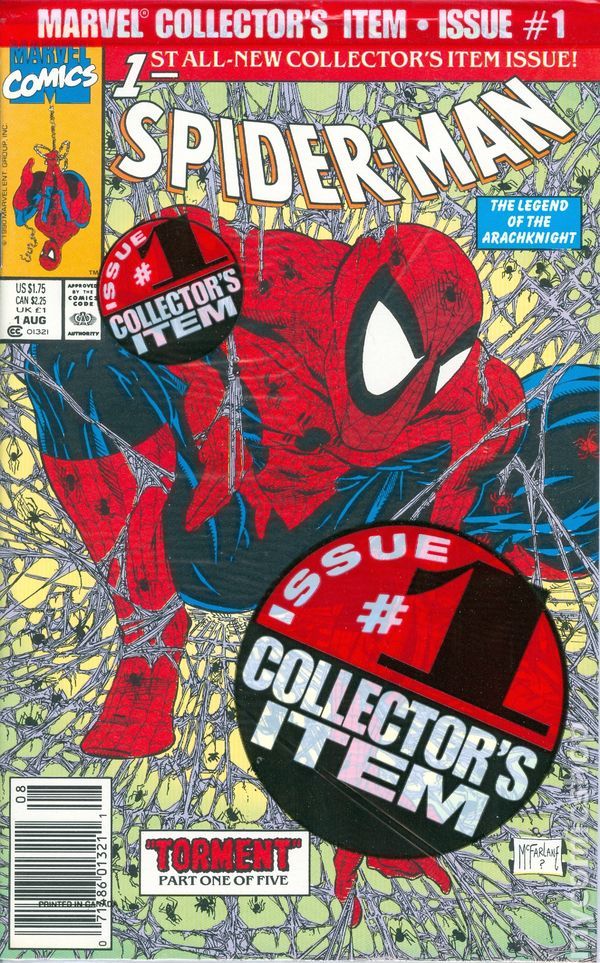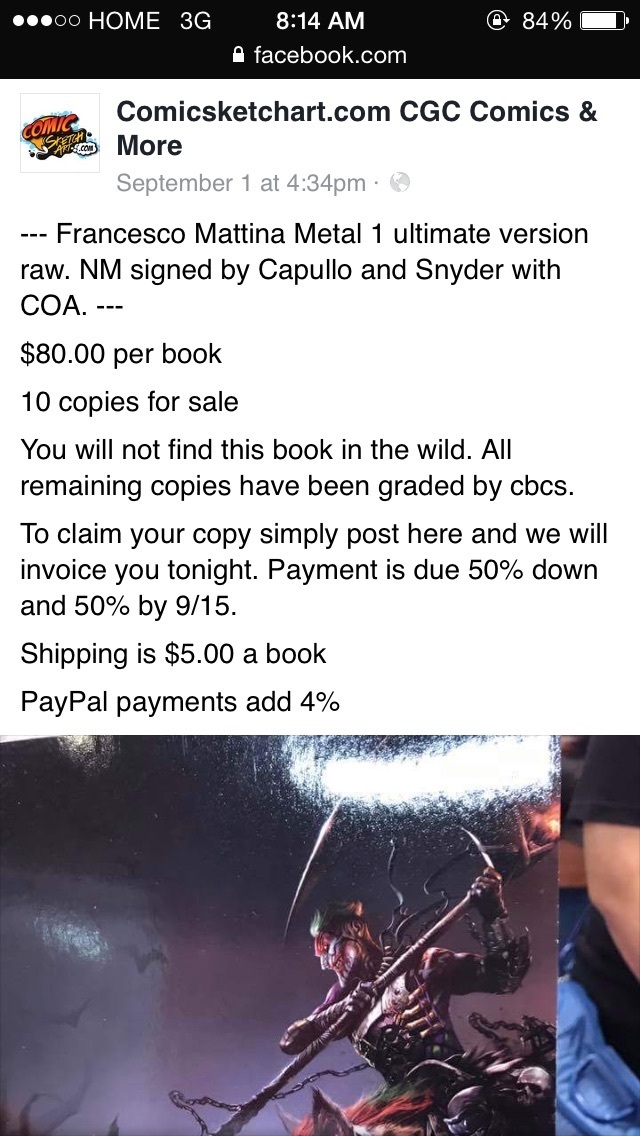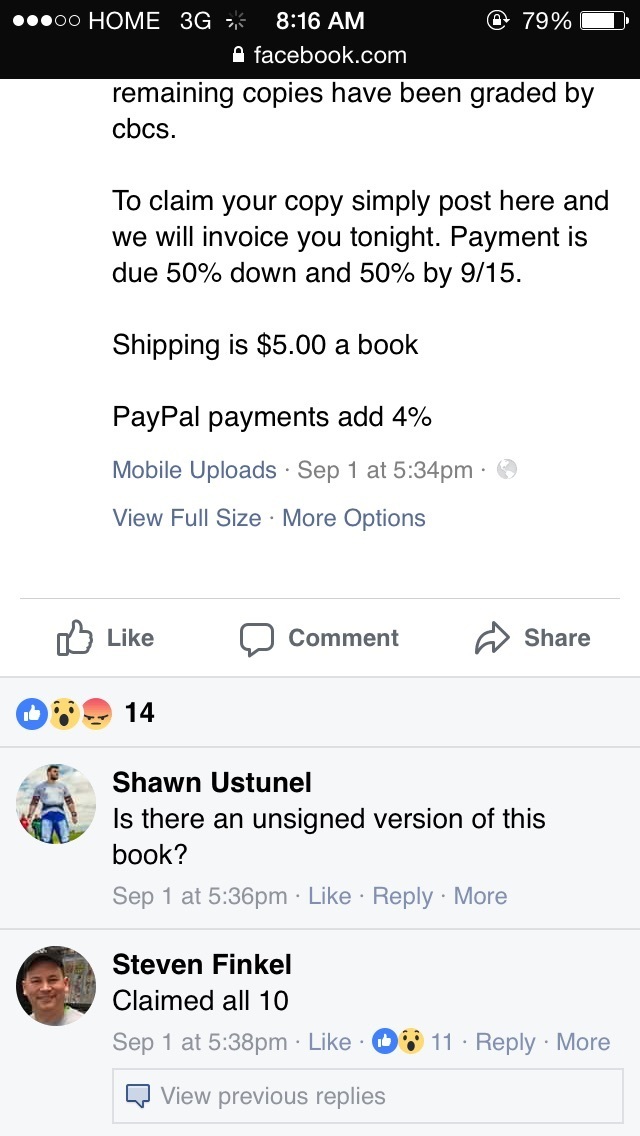Dispelling the myth of the INCENTIVE variant4358
 Collector Collector
|
DocBrown private msg quote post Address this user | |
| So, a lot of people have been running around the comics world for the better part of a decade, trying to tell others what they believe are the "print runs" of the various "incentive variants" are and have been. First, let's make this clear: Marvel, DC, and others DO NOT release print run information for virtually ALL of their books, regular, incentive, retailer, whatever. A few publishers do, like Chaos and whatnot, but Marvel and DC have been famously tight lipped about it. Second, the various retailer ordering incentives that first started about 2004 (NOT the 90's, as some have claimed!) according to certain ratios (and I remember The New Avengers being among the very first; the McNiven cover to #1 was, if I remember correctly, a 1:15, and #2 was 1:16, #3 1:17, etc) are for ORDERING purposes only. That is, if an incentive was 1:50, that means...and ONLY means...that a retailer had to order 50 copies of the regular version to receive/purchase ONE copy of the incentive variant. It DOES NOT MEAN, and has NEVER meant, that therefore the variant is printed according to the ORDERING RATIO. That number means absolutely nothing, OTHER THAN that's how many copies a retailer would have to order of the regular to get one copy of the variant. We know that for several reasons, which I'll get to in a minute. This program was designed for one thing, and one thing only: to get retailers...or "incentivize" them...to order more copies of the regular book. If they were ordering 37 copies already, eh, why not, order 50. Nothing more, nothing less. Now...how do we know that the ORDERING RATIO has nothing to do with the PRINT RUNS of the variants? First, and most importantly, common sense. Marvel and DC have never stated...ever, anywhere...that those ratios are tied to the print run in any way. As stated above, Marvel and DC don't reveal print run information, with very, very few exceptions. Why? Because: competition. If those numbers were tied to the print run, it makes sense that Marvel, DC, et al would state that, because it would be a "limited edition"...they don't, because they don't want to tie themselves down to a certain number (though they have certainly done that in the past.) But they don't, and as far as the ratio incentives go, never have. Second, we know the books aren't printed to order (plus a trivial amount to cover damages.) We know this because, for the last decade, Marvel, DC, and others have used RATIO INCENTIVES as promotional copies for things like the Diamond Retailer Summits (of which I have attended several in the last several years.) If they were printed to order, they would not be able to hand out HUNDREDS of such copies at these events. Third, we know the books aren't printed to order because the publishers have, on a regular basis in the last several years, had SALES through Diamond of RATIO INCENTIVES. If they were printed to order, it would not be possible to sell HUNDREDS (if not THOUSANDS) of such books, long after the fact. Fourth, the numbers used by people to claim "estimates" of these ratio incentives are built on top of an already spurious number: the SALES INFORMATION reported by Comichron. As Comichron clearly states, the numbers it receives from Diamond are SALES numbers in NORTH AMERICA. They ARE NOT "print" numbers, and never have been. Comichron ONLY REPORTS what initially sold in North Am. What about England? What about Australia? What about the other standard English copies that are sold worldwide? None of that information is included. And, again...the ratio has to do with ordering...it's not tied to the print run of the regular book in the first place. In other words, if Comichron reports that Diamond sold 89,373 copies of Comic Book X #5, which had a 1:100 ratio incentive...it does NOT mean, and never HAS meant, that the publisher only printed 894 copies of that ratio incentive, plus enough to "round off the case." The publisher printed as much as they wanted...1000 copies, 1500 copies, 5000 copies, whatever...and no one but they and the printer knows for sure how much they printed. So, trying to mathematically compute a print run number, using an ORDERING ratio, based on a SALES number...you can see the silliness of such a venture. Don't get me wrong...they're easy numbers, and tempting to use, no doubt, especially in the absence of hard numbers from the publishers. But they are also totally WRONG numbers, built on FALSE premises, and aren't of any use in any meaningful way. The answer, of course, is that the publishers print whatever they want, in whatever number they need. The ONLY requirement they have is that they print ENOUGH copies to fill initial orders; other than that, they are free to print whatever they want, for any reason they want, and they certainly have, do, and will continue to do so. Don't fall for the hype. If you see a "1:X" ratio, the only thing you know for certain...unless the publisher tells you otherwise...is that that's what it took the retailer to order to receive a copy. Anything else...EVERYTHING else...is meaningless speculation. |
||
| Post 1 • IP flag post | ||
 Collector Collector
|
DocBrown private msg quote post Address this user | |
| Also...while there have been people claiming the "incentive variants" have been around since the 90's, that's not true. The RATIO incentives have only been around since 2004-2005. That is, the offer of "if you order X amount of the regular, we'll give you/you can buy 1 copy of the variant." Yes, there have been "1 of 4" variants going back as early as 1989. Legends of the Dark Knight #1 was a type of that book: there are four colors, and they were all distributed evenly, so, say, the Blue copy was a "1 of 4." Likewise, the Platt Prophet #4 variant from 1994 was ALSO a 1 of 4 variant. In the boxes, there were 3 copies of the regular, and 1 variant, repeat. Same with the X-Men #342 and #354 variants, and the #377 and X-Men #97 variants. But that's not how they were marketed, and that's not how they were ordered. "1:X" didn't become a marketing tool...at least with Marvel or DC or the other major publishers...until 2004-2005. In other words, they weren't INCENTIVES to order additional copies of THAT specific book. |
||
| Post 2 • IP flag post | ||
 Collector Collector
|
1243782365 private msg quote post Address this user | |
| No matter how many times you say this no one will listen. Everyone wants to pretend they have books with perceived low print runs and collectible value - they don't care about facts. Good post though. |
||
| Post 3 • IP flag post | ||
 COLLECTOR COLLECTOR
|
shrewbeer private msg quote post Address this user | |
| Granted they could very well have printed more than the estimate-by-ratio number, but why would they print exorbitant amounts more? They are in it for sales, not hoarding of books. On an "estimated" incentive of 500, the printer is not sitting on 100k more. That would be foolish of them. |
||
| Post 4 • IP flag post | ||
 Collector* Collector*
|
Towmater private msg quote post Address this user | |
| What I'm taking from threads like this one is the following... - Nobody but the publisher knows what the prints runs are or were for a title. - Print runs really don't matter. It is about supply and demand. If there is a demand there will always be a supply for those that can pay the toll. - Arguing about what the print runs is asinine because of the above. |
||
| Post 5 • IP flag post | ||
 Collector Collector
|
DocBrown private msg quote post Address this user | |
Quote:Originally Posted by jimmylinguini Thanks JL. Yeah, I know it's probably shouting into the hurricane, but you never know who it might affect. Here's hoping. |
||
| Post 6 • IP flag post | ||
 Collector Collector
|
moodswing private msg quote post Address this user | |
| The variant covers are still produced less than the actual cover. You are not saying the print runs are the same right? | ||
| Post 7 • IP flag post | ||
 Collector Collector
|
DocBrown private msg quote post Address this user | |
Quote:Originally Posted by shrewbeer Of course not, and no one is reasonably saying they are sitting on 100k or more. Reductio ad absurdum, here. They print what they want, for whatever reasons they have. If they have orders for 500, but want to print 3,000 for promotional purposes, they will. Have they...? No one knows but them. The takeaway is that the marketing "tool" of saying "this book only had so and so many copies printed" is a spurious one, and ought to be ignored. There are those who don't know any better, and use this information because they think it's legitimate, but there are also people who DO know better, who ignore the facts, and use this information anyways. It's fraud, albeit of a low intensity. An informed consumer is the best customer. |
||
| Post 8 • IP flag post | ||
 Collector Collector
|
moodswing private msg quote post Address this user | |
| I don't understand how these variant covers go for more than legit super hero first appearances. I was looking at a variant cover that had Magik on the cover. I was blown away by what it was selling for. | ||
| Post 9 • IP flag post | ||
 Collector Collector
|
Magellan private msg quote post Address this user | |
| Given that covers are usually printed separately from the books themselves, I'm not sure what the real takeaway here is. The print run is the print run. It wouldn't be hard to believe that publishers would get an approximation from retailer interest (based on previous interest even) and simply run a safe number of covers, right? | ||
| Post 10 • IP flag post | ||
 Collector Collector
|
DocBrown private msg quote post Address this user | |
Quote:Originally Posted by moodswing Heavens no. Industry estimates think that Marvel and DC wouldn't print less than 1,000 copies of anything, with very, very rare exceptions, because it just doesn't make sense for them to do so. Typically, it would be 1,000-10,000 copies, usually in the 2,000-4,000 range...total estimates, but not out of the ballpark, based on populations. Example: Batman #608 RRP. There are 295 grading events on the CGC census, and that doesn't include raw copies or copies slabbed by CBCS...and that book was "reported" to have had a print run of 200 from almost the beginning. This was given out at the DC Retailer conference in 2002 ("Retailer Roundtable Program" or "Retailer Reward Program"; apparently, no one knows for sure.) Obviously, there are more than 200 copies floating around out there. |
||
| Post 11 • IP flag post | ||
 past performance is no guarantee of future actions. past performance is no guarantee of future actions.
|
KatKomics private msg quote post Address this user | |
| I don't think there were even less than 30k print runs on the Superman Test Logo issues from 1987 that were supposedly only for a few select markets -issues that to my mind are true variants unlike todays issues | ||
| Post 12 • IP flag post | ||
 Collector Collector
|
DocBrown private msg quote post Address this user | |
| And print runs matter only in the sense that these numbers influence people to buy or not buy. It's human nature...someone sees "LIMITED EDITION!" and they're spurred to want it. Very few are immune, which is why it's used as a marketing tactic. How many comics have the words "Collector's Item!" printed on them? Why...? To sell more copies.  There's nothing wrong with legitimate (albeit, huckstery) sales tactics...but it needs to be true, or at least, potentially true. Saying "this book only had 278 copies printed!!" when the actual number might be 2,780...or ten times more...and no one but the publisher and printer knows...is deception. |
||
| Post 13 • IP flag post | ||
 Collector Collector
|
DocBrown private msg quote post Address this user | |
Too funny. The words "Collector's Item" appear FOUR TIMES on that bagged Spidey #1. FOUR TIMES! lol |
||
| Post 14 • IP flag post | ||
 past performance is no guarantee of future actions. past performance is no guarantee of future actions.
|
KatKomics private msg quote post Address this user | |
| Like at the grocery store - creates false scarcity - $5 per item (normal $6) limit of 5 per person!!! Better get 5 instead of the 1 you need. |
||
| Post 15 • IP flag post | ||
 Collector Collector
|
DocBrown private msg quote post Address this user | |
Quote:Originally Posted by KatKomics Exactly...or the half-empty shelf (when they've got 20 more pallets in the back.) "Oh no, they're running out! Better get ALL of them!" Almost no one is immune to this. |
||
| Post 16 • IP flag post | ||
 Collector Collector
|
KiloGraham private msg quote post Address this user | |
The Comic Mint has been putting out "Ultimate 9.8 editions" and claimed no raw copies will be made available. I believed that till I saw this: So I asked Doig about these when I saw him at fanexpo. He told me there's actually a store in the DC building where employees can pick up any variant they want. He told me he had 50 raw copies of a book that was advertised as no raw copies available. Oh and the person who bought all 10 raw copies he was selling.... Steven Finkel of the comic mint, trying to protect his brand. Doug also told me Steven tried to buy all the remaining copies Doug had so Doug raised the price.  So yes variants are BS. Buy what you like, don't buy strictly based on "print runs". |
||
| Post 17 • IP flag post | ||
 COLLECTOR COLLECTOR
|
shrewbeer private msg quote post Address this user | |
| @DocBrown "Print runs" ie variant ratio, should be taken with a grain of salt, agreed there. Not ignored though. It is flawed data, but still data. |
||
| Post 18 • IP flag post | ||
 Collector Collector
|
DocBrown private msg quote post Address this user | |
Quote:Originally Posted by shrewbeer Ordering incentive ratios have nothing to do with print runs, and never have. That's the point of this thread. Even using quotes conflates the two in a way that isn't appropriate. Quote: Originally Posted by shrewbeer As others have attempted to claim elsewhere. Of what value is "data" that is not just flawed, but not even data...? Wild guesses aren't "data." They're wild guesses. A guess of 13 is no more accurate or inaccurate than a guess of 3713, particularly on a book with no census data. The answer is "no one but the publisher and printer know what the print run is", and that should be the end of the discussion, until and if the publisher decides to release that information. |
||
| Post 19 • IP flag post | ||
 Collector Collector
|
DocBrown private msg quote post Address this user | |
Quote:Originally Posted by KiloGraham On an unrelated note, it has been the long tradition...and requirement of credit card processors...that businesses that accept credit cards DO NOT attempt to pass along their fees to their buyers. That Doug would do this...and tack on a pure profit of .1% to 1.1% (or more) as well...is just another example of the tacky practices of "businesses" like "comicsketchart" and the like. Gross. |
||
| Post 20 • IP flag post | ||
 Collector Collector
|
NilesPaine private msg quote post Address this user | |
Quote:Originally Posted by KiloGraham Balls is this from this year!?!?!? Is that legal of the company then to tell you that?? Isn't that false advertisement?? Interesting . . . Something similar happened with a Del Otto limited edition I recall. |
||
| Post 21 • IP flag post | ||
 Collector Collector
|
DocBrown private msg quote post Address this user | |
Quote:Originally Posted by NilesPaine Yeah, it's getting pretty gross out there. This kind of stuff only exists, though, because there are buyers for it. That's one of the reasons why I make such a big deal about it: because this type of bullshit goes on. |
||
| Post 22 • IP flag post | ||
 Collector* Collector*
|
Towmater private msg quote post Address this user | |
| The answer is obvious... The supply of something isn't what drives price. It is the demand. The proof for that would be a book like ASM 300. It keeps going up in value and there seems to always be a ton of them on the market for sale. The print run is a meaningless variable. Another example would be an OA sketch cover by artist x. It is a 1 of 1. If the artist isn't in demand then the price of it doesn't go up. Again, the "print run" is a meaningless variable. Another example is the artist signed book or artists signed books. People attempt to have this artist and that artist, and another artist, and yet another artist sign a book making something that would have the possibility of more than a handful exist in order to drive a higher asking/sale price. Unless there is a buyer/demand it may never sell at a breakeven price for the vendor now that artist are charging a different price for books that will be slabbed. |
||
| Post 23 • IP flag post | ||
 Collector Collector
|
DocBrown private msg quote post Address this user | |
| It is supply AND demand, both, inseparable, one not able to exist without the other. Infinite supply and no demand = no value. Infinite demand and (almost) no supply = infinite value. Infinite supply and infinite demand = no value. No supply and no demand = no value. There IS a point at which the supply of ASM #300 would be enough to sate THEN-CURRENT demand, and the price goes down...and, in fact, that is proven over time with the data we have. The demand for ASM #300 isn't infinite...far from it. My mother has absolutely no desire to own one, and would certainly throw it away, were it up to her. So, then, the supply does indeed have a direct effect on the value of the book. There's no such thing as "supply isn't what drives the price", because without supply, there can be no demand, on a philosophical level. There is no demand for that which does not exist. But, also on a philosophical level, what is it that determines demand in the first place...? A bunch of variables, both tangible and intangible, including perception. The print run is one such variable. The census is another. The estimate of extant copies is still another. Demand from others is still another. These things have a very real, demonstrable effect on demand, so to say the "print run is meaningless" is to ignore that intangible, unquantifiable, but still very real effect. |
||
| Post 24 • IP flag post | ||
 Collector* Collector*
|
Towmater private msg quote post Address this user | |
| Always an "interesting" perspective | ||
| Post 25 • IP flag post | ||
 I'm waiting.... (tapping fingers). I'm waiting.... (tapping fingers).Splotches is gettin old! |
Nuffsaid111 private msg quote post Address this user | |
| "flawed data" should not be ignored? Wow - is that like one should plant a live rock or ride a hornless unicorn? As of today I've officially heard everything. |
||
| Post 26 • IP flag post | ||
 Collector Collector
|
DocBrown private msg quote post Address this user | |
Quote:Originally Posted by Magellan Well, no, because incentives are used for so much more than just to get retailers to order more these days. Many incentives are used for promotional purposes. Remember, as you rightly point out, it doesn't cost a publisher much more to run off a couple thousand of each incentive variant, because the only additional cost is in the cover. If a printer runs 125,000 copies of the "guts" with 120,000 of the regular, and 5,000 are the variant, what does it matter to the publisher? The only additional costs are for the variant cover's artwork and the additional plate from the printer, which is negligible. I suspect that, wherever the decision is made (it used to be "circulation", but I'm not sure if they have such depts. anymore), they essentially say "ok, we need thus and such to fill orders, so and so for damages, and then X for promo purposes." Some of the ignorant (jaydogrules in particular) have made the specious argument that "why would a publisher sell these long after the fact for 'pennies on the dollar'...?" A possible answer is because, again, it cost the publisher next to nothing to print them, so even if they're selling them for 75 cents each through Diamond...making 30 cents on each one...they're A. supporting the retailers, who can then turn around and sell them for cover price or so, which is PROMOTIONAL PURPOSES, and B. they're STILL MAKING SOMETHING on those 30 cents a copy, amortized over the entire print run, plus the negligible additional costs for the art and plate, and whatever storage they pay. At the point where they're selling those incentives...months or years after the fact...those books have already paid for themselves, long ago. These numbers are just estimates, by the way, but they're not too far off. I have seen many ratio incentives selling for 75 cents through Diamond. |
||
| Post 27 • IP flag post | ||
 Collector Collector
|
KiloGraham private msg quote post Address this user | |
| @NilesPaine Yes that Ultimate edition was released not even a month ago. I haven't received my CBCS 9.8 graded copy yet and there's already raw copies being bought up by the dude who claimed their would be no raw copies available. Not only raw copies, but artist signed raw copies. I'd be willing to bet those raw copies are also signed by Glapion and Mattina at NYCC then submitted to cgc, because CSA are cgc facilitators. @DocBrown all facilitators using PayPal will require you to add a % to cover PayPal fees, unless you send it friends and family. Even Trinity, a CBCS facilitator, adds the fee. You are right that businesses accepting credit cards cannot pass on the fee they are charged to the buyer (you can actually report companies that do directly to the credit card issuer), but it's not the CC charging the fee it's PayPal. |
||
| Post 28 • IP flag post | ||
 Collector Collector
|
DocBrown private msg quote post Address this user | |
| Now...that all said, that doesn't mean that a LOT of these books don't get trashed and written off by the publisher. They do. I suspect that's where a lot of them went. Look at ASM #667 and #678. Those books, by all rights, should not be rare at all, and yet look at the obscene prices they command, because the supply just doesn't exist. I don't think...at all...it's because they only printed "a case" of each, as people like jaydogrules contends. That would be stupid. I think it's because of circumstances, and either the rest of the books...maybe a couple hundred, maybe a couple thousands...are warehoused somewhere...or they were destroyed due to lack of demand. Time will tell. |
||
| Post 29 • IP flag post | ||
 Collector Collector
|
DocBrown private msg quote post Address this user | |
Quote:Originally Posted by KiloGraham Understood, but 1. using friends and family to pay for merchandise is fraud, and 2. adding the fee may not be illegal, but it's tacky. Yes, I'm well aware that Paypal is charging the fee, because Paypal is acting like a credit card company and processing the payment. It should be a "cost of doing business" and I don't add it to anyone's amount when I sell, and never would. Also, I understand the "3% discount for cash purchases" might appear to be six of one, half a dozen of the other, but it doesn't benefit the merchant. |
||
| Post 30 • IP flag post | ||
Thread locked. No more posts permitted. Return home.
